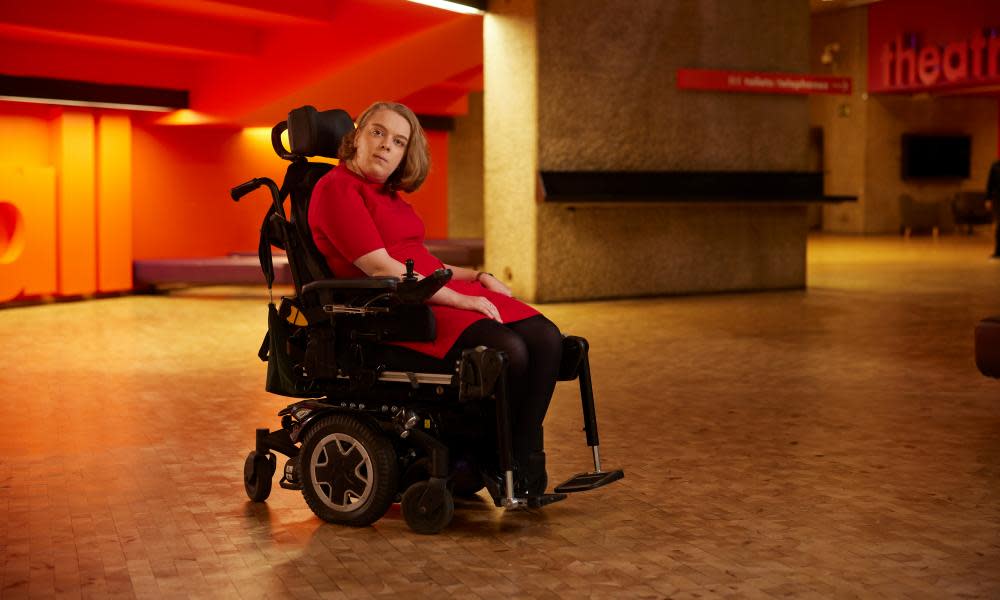‘We know they can do it when it suits them’: theatre became more accessible during Covid. Will it last?

Going to the theatre in a pre-pandemic world, my first question was always whether I could use the toilets. With so many of the UK’s theatres dating back decades, or centuries, even the disabled toilets are often tucked into tiny, pokey spaces that could be fine for a small manual wheelchair, but not my assistant and bulky powerchair. Even disabled loos can be inaccessible for the disabled.
Like going anywhere with a wheelchair, a trip to the theatre requires ridiculous planning. Just booking a seat is often a challenge. Most theatres still don’t allow you to buy wheelchair tickets online, and good luck trying to find out if an assistant goes free. But what has stopped me – and many other disabled or chronically ill people – from regularly going to the theatre is simply a lack of energy. By the end of a working day, I was often too exhausted and sore to spend more hours in my chair.
“Journeys out are too tiring, require planning, and often have to be cancelled,” John Maidment, an avid theatre fan who is disabled, told me. “Most theatre seating is too uncomfortable, and I can’t move about, shift position or exercise a limb as it annoys and distracts others.”
All of which made the pandemic-induced shift to online performances a welcome change: suddenly, theatre was newly accessible, and not just for those with mobility impairments. For deaf, hard-of-hearing and visually impaired audiences, online performances suddenly came with captions, British Sign Language and audio-description as standard. And the option to watch from home helped some autistic and learning-disabled people to enjoy the theatre free from strict expectations around silence and stillness.
Related: 50% of UK theatres streaming shows online during Covid revert to in-person only
Some of the UK’s biggest theatres are committed to maintaining an online theatre programme after Covid. The Barbican in London is keeping some shows as purely online experiences, while the Young Vic has committed tois streaming all of its main-stage shows. Sadler’s Wells launched its Digital Stage last year, and will keep it into 2022. But others are reducing their streamed performances, perhaps in the hope of getting people inside theatres again. The Birmingham Hippodrome and the Royal Exchange in Manchester do not list any online performances at all. And in the rush back to full houses, captioned, BSL-interpreted and relaxed performances are once again becoming rare, with most theatres providing only one or two accessible showings of each play.
Andrew Miller, who was the UK government’s disability champion for arts and culture before setting up of the Disability Arts Alliance, says the lack of social distancing is keeping him out of his own sector. He used to attend roughly 100 shows a year, but now describes himself as “part of the socially excluded”. When he declines invitations with concerns about Covid, the response from theatres, he says, is “we hope to see you when you feel comfortable” – as if there’s nothing that could be done. In reality, theatres know – because they’ve been told – how they could do to help: simple measures like mandating masks, checking vaccine status, requiring proof of a negative test, and keeping a small section for social distancing would all go a long way. Such measures have been proven to work on Broadway. But the UK theatres are turning a blind eye.
“We are determined that deaf, disabled and neurodivergent audiences are not left behind, as was so often the case pre-pandemic,” says Nickie Miles-Wildin, the associate director of Graeae, a theatre company for deaf and disabled creatives. She hopes that more theatres will enforce social distancing at their performances to allow clinically vulnerable people to return, as well as offering online shows. (Graeae’s current production, 10 Nights, is available as a download.)

And then there’s still the stairs, the narrow seating and, of course, the toilets. That theatres have remained pokey is especially galling when many venues had put off making such improvements before the pandemic as they would have to close for renovations. Historically, some theatres have hired “access consultants”, who advise on how to improve accessibility but may not necessarily be disabled themselves. Hiring disabled professionals would take the burden off disabled fans who often end up advising theatres for free; people such as Shona Louise, a theatre photographer and wheelchair user who campaigns for better access. It is “frustrating” that theatres have not used their time in lockdown to improve accessibility, she says. “We had such an opportunity to increase accessibility across the board – and we just decided not to take that up.”
London’s Old Vic has used the pandemic to install more accessible loos and create a lowered section of its bar that will enable wheelchair users to more easily order drinks (always a bonus, in my book). But there has been some regression, too. Shona and other activists recently complained when it emerged that the extremely popular Henry VIII musical, Six, would be moving from the Lyric to the Vaudeville theatre, which does not have an accessible loo. The Vaudeville’s stairlift (the only way wheelchair users can access the stalls) is unable to handle powerchairs. Conversations with the Vaudeville had been “constructive”, she says – but ultimately they should never have been necessary in the first place.
The answer to all these issues is to have more disabled people working in theatre. “There is no one fighting for us on the inside,” Shona says. As theatres reopen their doors, the back-to-normal narrative is, as John says, “nothing less than a betrayal. We know they can do it when it suits them.”


